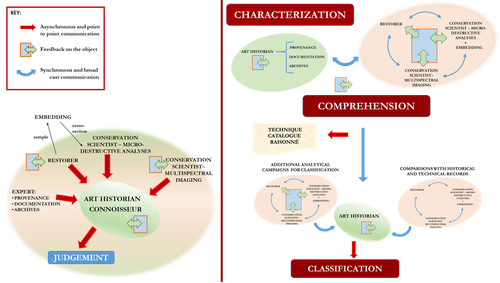Best practice to support the authentication of paintings

An art collection is generally composed of a set of original works, copies and sometimes fakes. Since today to buy art works is considered an investment, it becomes of great interest the possibility of check the authentication of an artwork through a scientific verification with innovative methodologies. The research relating to authentication and attribution is currently characterized by a lack of discussion on the use of the necessary protocols; there is therefore a need to identify innovative methodological paths involving both art history and scientific methods. The aim is to develop a methodological path that allows to carry out an evaluation as objective as possible through the use of diagnostic-analytical technologies. The technical assessment, which completes the aesthetic, stylistic, iconographic and historical information obtained, determines the attribution and authentication of artworks. Moreover, the ever-increasing interest about the techniques able to highlight the stages of the elaboration of a painting adds value to the aspects of conservation, fruition and valorization. The applicability of the project is made possible by the opportunity to test and develop the protocol on the numerous case studies investigated by the Conservation Science Laboratory within the commercial activity and on wide diagnostic campaigns linked to the institutional projects.
The project is financed by funds from the Diagnostic Laboratory, pertaining to the Diagnostics & Art research line and deriving from R_PRIV - Projects with third party funds, tariff and liberal contributions, ACT_PR - Third party contracts from private funds, SPP_PR - Tariff contracts from private funds, CNTR_LB_PR - Liberal contributions from private funds, and with the participation of Lumière Technology.
Connected PhD project: Development of a protocol of best practices for the authentication of paintings (October 2016 - September 2019 - tutor Vandini Mariangela).
Connected PhD project: Il “catalogue raisonné” come processo giuridico di autenticazione. Il caso di Benedetto Gennari il Giovane. (November 2019 – tutor Ghelfi Barbara).
Scholarship (2016-2018) connected to the project: "Treatises, documentary sources and scientific analysis for the study of painting techniques related to the Italian and European areas between the 15th and the 18th centuries".
Fixed term contract (2019-2020) connected to the project: “From the transparencies of glacis to the brilliance of the acrylic: techniques and materials between 15th and 20th centuries”.
Research fellowship (2020- ) connected to the project: "Treatise, documentary sources and scientific analysis for the study of Guercino's painting technique and Baroque painting".
Cultural Agreement - Lumière Technology (n.80/2019 prot.n.1323): https://beniculturali.unibo.it/it/dipartimento/accordi-e-collaborazioni
Research group: Vandini Mariangela (associate professor, Unibo), Ghelfi Barbara (associate professor, Unibo), Matteucci Chiara (senior graduated technician, Unibo), Volpe Alessandro (associate professor, Unibo), Tusini Gian Luca (assistant professor, Unibo), Garzia Giuseppe (assistant professor, Unibo), Apicella Salvatore Andrea (Lumière Technology, Paris), Cataldo Martina (scholar fellow, Unibo), Fiorillo Flavia (alumna, Unibo), Stenta Pasquale (PhD student, Unibo), Tarantola Gaia (Unibo), Cotte Pascal (Lumière Technology, Paris), Hajdas Irka (Laboratory of Ion Beam Physics, ETH Zurich), Hendriks Laura (Laboratory of Ion Beam Physics, ETH Zurich), Rizzà Laura (adjunct professor, Unibo), Bevilacqua Fabio (adjunct professor, Unibo), Gnignera Elisabetta (historian of costume).